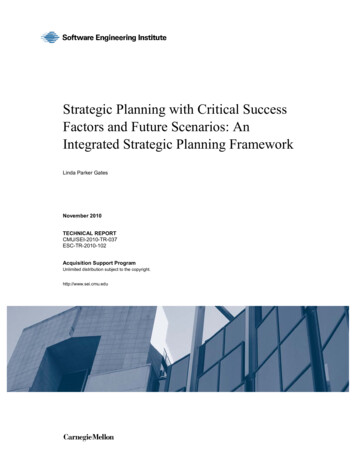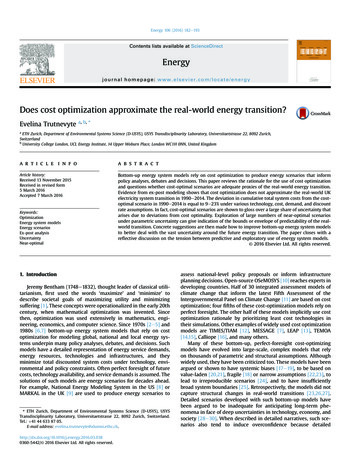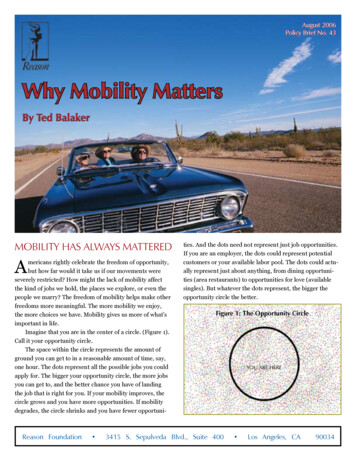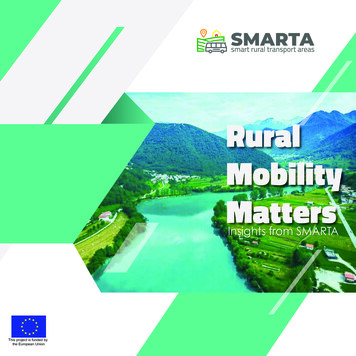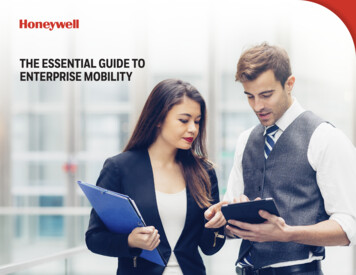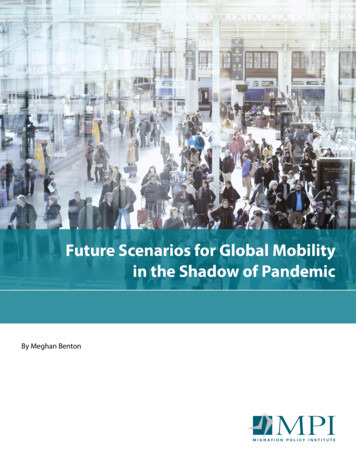
Transcription
Future Scenarios for Global Mobilityin the Shadow of PandemicBy Meghan Benton
INTERNATIONAL PROGRAMFuture Scenarios for Global Mobilityin the Shadow of PandemicMeghan BentonMigration Policy InstituteJuly 2021
ContentsExecutive Summary. 11Introduction. 42Cross-Border Mobility in the First Year of the COVID-10 Pandemic. 53A.The Effects of the Pandemic on Different Kinds of Mobility. 6B.The Role of Mobility Restrictions in Managing the Pandemic. 10C.Good News on the Horizon, or Move Bumps in the Road?. 13Scenarios for the Next Three Years. 14Scenario 1. Pandemic Proofing: A 9/11 Moment for Border Management and Health. 14Scenario 2. Mobility with Friends: Travel Bubbles and Regional Accords. 16Scenario 3. Chaos and Fragmentation. 19Scenario 4. A Return to the Pre-Pandemic Status Quo. 214Policy Considerations. 22A.B.C.5What Wraparound Systems Need to Accompany Vaccines?. 22What Should the Interim System Look Like?. 26How Could Health Screening Be Better Coordinated?. 27Conclusion. 29About the Author. 32Acknowledgments. 33
FUTURE SCENARIOS FOR GLOBAL MOBILITY IN THE SHADOW OF PANDEMICExecutive SummaryThe COVID-19 pandemic has transformed international mobility, decimating tourism and business travel;cutting the lion’s share of seasonal and temporary labor migration; placing refugee resettlement on hold;and halting or holding up visa processing across all streams, frominternational students to family unification. More than 18 monthsMore than 18 months onon from the first round of travel bans in January 2020, it is clearfrom the first round of travelthat restarting mobility is not a linear process. The developmentbans in January 2020, it isof several effective vaccines has not offered the silver bulletmany hoped, especially against the backdrop of a highly unevenclear that restarting mobilityglobal vaccine rollout and questions about whether the vaccinesis not a linear process.will have the same level of efficacy against newer, more virulentvariants.To develop a road map for opening up and clarify the choices that lie ahead, national governments andinternational organizations can benefit from exploring possible scenarios for what international mobilitycould look like two to three years hence: Scenario 1: Pandemic Proofing. In this scenario, the pandemic will become a 9/11 moment forborders and mobility, with public health decisively shaping decisions on whom to let into a countryin much the same way as security considerations did in the wake of the September 11, 2001, terroristattacks. Under this scenario, new international standards and procedures have been agreed aroundrisk assessment, time limited emergency travel restrictions, expanded health data sharing, andconsistency on testing and screening. The cornerstone of this new system is digital health cards thatallow governments, airlines, and private institutions to verify an individual’s COVID-19 vaccinationstatus, although testing and quarantine requirements remain in place as an alternative pathwayto travel for those who have not been vaccinated. By increasing and standardizing requirementsfor formal cross-border movements, the new system has created winners and losers: on one handbenefiting mobility pathways that can cope with additional layers of screening (such as refugeeresettlement), but on the other hand amplifying the existing divide between “movers” and “nonmovers” and creating an even more lucrative market for smugglers. Scenario 2: Mobility with Friends. In this scenario, the creation of international processes andstandards is still a work in progress in 2024. As a stopgap, regions have pursued different approachesreflecting their mix of risk tolerance, needs, resources, capacity, and past pandemic experience. Whilesome regions have swiftly standardized public-health procedures, others have struggled to maintainagreed metrics and procedures. Some travel bubbles have been ephemeral, bursting almost as soonas they are formed. The most successful have been undergirded by strong bilateral cooperation andmutual trust, allowing countries to agree on threat assessment systems that automatically trigger a setof additional travel or medical restrictions across the region. But closer cooperation within regions hasled to a fragmented global picture, with ongoing disruptions especially in regions that lack capacity.MIGRATION POLICY INSTITUTE 1
FUTURE SCENARIOS FOR GLOBAL MOBILITY IN THE SHADOW OF PANDEMIC Scenario 3: Chaos and Fragmentation. This scenario would see a vast amount of experimentation,yet largely at the national level, with the picture of global mobility from 2021 through 2024 stuck ina dance of two steps forward two steps back. A plethora of new tools and solutions have emerged,yet most struggle to get beyond the piloting phase. Those that do succeed are not interoperable andagreement has stalled on picking the winners, creating a fragmented landscape. Decisions abouttravel restrictions and health requirements are last minute and poorly communicated, leading tochaos at borders and large populations of stranded travelers and migrants. Some regions have seen atotal breakdown of trust in how neighboring countries are managing the pandemic. Meanwhile, thedeeply uneven vaccine rollout continues to carve stark divisions at the international level. In such ascenario, the concertina of opening and closing borders continues, especially as further variants ofthe virus emerge. The chill on international migration casts a long shadow: most countries maintainmovement of essential health workers, certain high-skilled migrants, and returning nationals andresidents; but most other migration and mobility remains stalled. Lingering quarantine and otheronerous requirements continue to stifle business travel and tourism, while also fueling irregularmigration by excluded groups. Scenario 4: Pre-Pandemic Status Quo. Perhaps the most unlikely scenario is a return to prepandemic norms around travel. For this to happen, COVID-19 would have to fizzle out in this period tothe point that it no longer poses a significant threat, with almost all countries reaching herd immunitythrough some combination of vaccines and/or biological immunity. In this situation, governmentsface pressure to use international tourism as a defibrillator for sputtering economies and thus to liftall border and travel restrictions. In practice, however, a lingering lack of trust in border and mobilitymanagement continues to dampen cross-border movements beyond their official lifting, especiallysince even localized and readily contained outbreaks could easily trigger panic. The looming specter ofanother pandemic has prompted governments to carry out a full postmortem on the COVID-19 crisis,revisiting the rules around border closures and health screening standards to prevent a repeat of 2020.While these scenarios are presented as thought experiments, in reality they may not be mutually exclusive.Regional cooperation may be a stopgap that furnishes the building blocks for the eventual developmentof a global system; equally, regionalism may tip back into unilateral experimentation if trust breaks downamong neighboring countries. And even in the unlikely scenario that mobility snaps back to the pre2020 status quo, governments and international organizations may nonetheless begin the process oftransforming border management to secure against future pandemics.If governments wish to restart mobility more quickly, they will need to coordinate closely with one anotherand think across the travel and migration continuum to develop well-thought-out measures and minimizeunintended effects. The following questions merit further consideration: Can vaccines unlock global mobility? While several highly effective vaccines have emerged, theyare unlikely to be a panacea for restarting cross-border movement, at least in the near term, with new,more contagious variants circulating and the efficacy of different vaccines varying, including againstthese variants. Deeply uneven vaccine access has made international organizations and middle- andlow-income countries skeptical of using “vaccination passports” as the key to reopen mobility. AndMIGRATION POLICY INSTITUTE 2
FUTURE SCENARIOS FOR GLOBAL MOBILITY IN THE SHADOW OF PANDEMICgovernments pursuing this model are facing the challenge of verifying vaccine records quickly andsecurely, in a way that reduces fraud yet protects individual health data. The landscape is alreadyhighly fragmented, with a plethora of emerging digital solutions. An important principle will bedesigning new systems around the needs of all movers, including those without digital proficiency oraccess. A broader question is how vaccine requirements might reshape migration dynamics, especiallygiven migrants and refugees are often systematically left out of national vaccine campaigns. Withoutgreater vaccine equity worldwide, governments will need to maintain complementary measures, suchas testing and quarantine, for the foreseeable future to avoid further entrenching the gap between“movers” and “non-movers”—but maintaining parallel systems could be costly, add more complexityfor individual passengers, and further deepen the pressures on border enforcement and traveloperators. What role should testing and quarantine play? While there have been huge advances in healthprocedures, few have been grounded in an evidence-based risk management framework. Limitedinternational coordination often leads to duplication and complexity, with travelers facing countlesstests and large costs per trip. In the first year of the pandemic, governments had a high risk thresholdand therefore could tolerate or even encourage opaque, costly, and complex systems that acted as ade facto deterrent to international migration and travel. As they seek to open up, they will need to bemore strategic, forward looking, and transparent to avoid disincentivizing travel as a whole, lockingout certain groups of movers indefinitely, and/or pushing people to move irregularly. Working withlike-minded countries could also help reduce unnecessary bureaucracy. Governments will need todecide whether to invest political and financial capital in an interim system based on testing andquarantine that works for today’s pressures or to build an infrastructure that is more enduring andcan withstand different public-health scenarios, including the end of the COVID-19 pandemic andpotentially the emergence of a new viral outbreak several years hence. How can health screening be better coordinated? Whatever health procedures are put in place,fully restarting migration and mobility depends on building more predictability and transparency intothe system. Governments will need to work together to develop shared risk assessment metrics formanaging this pandemic and agree on steps to take when future public-health crises emerge to avoidrepeating the chaos of migrants and travelers stranded amid uncoordinated border closures in 2020and, ideally, to prevent viruses from spreading so quickly. Regional agreements have been fragile, evenin areas of common governance, such as the European Union, and among countries facing a similarCOVID-19 case picture, such as Australia and New Zealand. Nonetheless, regional coordination is likelyto be the basis for new agreements over health standards and procedures. At the international level,the COVID-19 pandemic exposed the limitations of the International Health Regulations’ ability toguide a response to a fast-emerging, cross-border threat and the challenges of ensuring compliancewith measures that exist on paper. In the last year, countless coordinating initiatives and task forces ledby different international bodies and UN agencies have emerged. What is lacking is a meta-coordinatorto bring these disparate initiatives together and ensure that the new border health system worksfor all kinds of travelers and people on the move, including refugees and other vulnerable migrants.The impact of COVID-19 on mobility is a cross-cutting challenge that will require new, more nimblegovernance structures to address.MIGRATION POLICY INSTITUTE 3
FUTURE SCENARIOS FOR GLOBAL MOBILITY IN THE SHADOW OF PANDEMICWhile the next three years may see the pandemic brought under control in some jurisdictions, a full returnto pre-pandemic levels of travel, migration, and mobility is unlikely. The main priority now should be tooutgrow the current picture of fragmented, frequently shifting policies in favor of transparent, equitable,and risk-proportionate rules. Building a system that is easy for people to comply with will serve bothpublic-health and mobility objectives. In this regard, decisions will need to be taken about how to rethinkmobility for the long haul—including how to manage cross-border health challenges going forward; how tocommunicate clearly about risk mitigation strategies; and how to strengthen international coordination andlay the groundwork to prepare for the next public-health crisis. Whatever decisions are made now shouldtherefore take a long-sighted view, strengthening border procedures for numerous scenarios, not just theone before us.1IntroductionThe year 2020 was a watershed moment for human migration and mobility. Between March and May 2020,almost every country and territory closed ports of entry and enacted a mix of measures banning, limiting, orattaching additional conditions to travel.1 The COVID-19 pandemic is estimated to have halted almost threequarters of international tourism in 2020,2 and to have significantly reduced temporary and permanentlabor migration.3 Many countries severely curtailed opportunities for family unification and to seek asylum,and almost all halted refugee resettlement. Visa processing across all streams was placed on ice by embassy,consulate, and processing center closures. Millions of travelers, migrants, and seafarers were left stranded,often in highly vulnerable circumstances. It is uncertain how and on what timeline these different forms ofhuman movement will recover. Some commentators have gone as far as to claim that we may be witnessingthe end to the “age of migration,” predicting deep and long-lasting scars across the global migration systemfor the foreseeable future.4More than a year since cross-border movements werevirtually stopped in their tracks, many mobility streams have It is uncertain how and on whatremained frozen while some have begun to see haltingtimeline these different forms ofand uneven reopening. Countries are experimenting with ahuman movement will recover.patchwork of screening, testing, and quarantine measuresto facilitate movement, but with little coordination amongthemselves—let alone agreed-upon global standards to guide these efforts. They have also struggled toquickly adapt to new scientific and public-health information. While the rollout of COVID-19 vaccinationsstarting in early 2021—with campaigns now underway in almost every country, territory, and area5—isaccelerating the cautious reopening of borders, the emergence of new variants, including the B.1.1.7 orAlpha, B.1.351 or Beta, and B.1.617 or Delta strains,6 has sparked another wave of travel restrictions. To open123456Meghan Benton, Jeanne Batalova, Samuel Davidoff-Gore, and Timo Schmidt, COVID-19 and the State of Global Mobility in 2020(Geneva and Washington, DC: International Organization for Migration and Migration Policy Institute, 2021).World Tourism Agency, “Tourism Back to 1990 Levels as Arrivals Fall by More than 70%” (news release, December 17, 2020).Organization for Economic Cooperation and Development (OECD), International Migration Outlook 2020 (Paris: OECD Publishing,2020).Solon Ardittis and Frank Laczko, “Introduction - Migration Policy in the Age of Immobility,” Migration Policy Practice X, no. 2 (2020).University of Oxford, “Our World in Data: Coronavirus (COVID-19 Vaccinations),” accessed June 25, 2021.This report uses the recently adopted system of Greek letter names for its list of variants of concern to avoid the problem ofstigmatizing regions. See World Health Organization (WHO), “WHO Announces Simple, Easy-to-Say Labels for SARS-COV-2 Variantsof Interest and Concern” (news release, May 31, 2021).MIGRATION POLICY INSTITUTE 4
FUTURE SCENARIOS FOR GLOBAL MOBILITY IN THE SHADOW OF PANDEMICup safely, governments face the challenge of building out the nascent infrastructure of health screening, riskassessment, and border processes—and potentially creating systems to standardize and verify vaccinationrecords.This report explores how different policy choices could shape the next few years of human mobility. Itfirst describes what happened in year one of the pandemic—how border closures and travel restrictionsaffected different types of mobility, and what was learned about the role of such measures in pandemicmanagement. It then sets out some possible scenarios for the next two to three years. Finally, it identifiespolicy questions that will be critical to address in the coming months and makes some tentativerecommendations. The report focuses primarily on the position of and challenges facing advancedeconomies, where the vaccine rollout has generally moved more quickly, placing them in a position to beginthinking about opening up. However, it draws from worldwide lessons and experiences and makes globalrecommendations where possible.2Cross-Border Mobility in the First Year of theCOVID-19 PandemicThe COVID-19 crisis had an unprecedented impact on human mobility, starting in the first few monthsof 2020. By the end of March 2020, governments had issued 43,300 travel measures, and every country,territory, and area worldwide was subject to at least 70 travel bans.7 In April and May, the number ofinternational air passengers was down 92 percent relative to the same months in 2019.8 A patchwork of fastchanging travel restrictions of various kinds emerged over the course of the year—from entry restrictionsbased on travelers’ route or nationality to visa suspensions and new conditions for entry, including healthrelated requirements (e.g., mandatory quarantine, medical certificates, or health screening).9 At the sametime, countries made numerous exemptions to entry restrictions, such as for their own nationals and familymembers or for essential workers. Beginning in Summer 2020, some governments and regions begancautiously opening back up, shifting increasingly from blunt tools such as travel bans and border closures tomore nuanced systems involving health-based entry requirements that seek to adapt to changing levels ofrisk.But this process of reopening to international migration and travel has been nonlinear. Travel bubbles(quarantine-free agreements between countries or cities) have been created and then abandoned; bordershave been opened and then quickly shut again; exemptions have been expanded and then narrowed;and health-related travel measures have been introduced only to be hastily amended. For instance, inthe European Union, Member States agreed in January 2021 to consider reimposing travel restrictions fornon-essential intra-EU movement,10 and in May 2021, the European Commission called on Member StatesBenton, Batalova, Davidoff-Gore, and Schmidt, COVID-19 and the State of Global Mobility in 2020.Big Data UN Global Working Group, “ICAO: Operational Impact–Operational Impact on Air Transport,” accessed February 4, 2021.For an overview of how these restrictions have unfolded over time in different regions, see Benton, Batalova, Davidoff-Gore, andSchmidt, COVID-19 and the State of Global Mobility in 2020. The report describes three main phases in 2020: mobility lockdown,where governments and authorities issued tens of thousands of travel restrictions and bans (from March to May); phasedreopening, where travel bans were increasingly replaced by health measures, including predeparture COVID-19 test requirements(June to September); and new waves and mutations, where countries sought to build capacity for health screening andprocedures amid concerns about spiraling cases and new variants (October to December).10 Hanne Cokelaere, “EU Leaders Consider Restrictions for Non-Essential Travel,” Politico, January 22, 2021.789MIGRATION POLICY INSTITUTE 5
FUTURE SCENARIOS FOR GLOBAL MOBILITY IN THE SHADOW OF PANDEMICto take coordinated action to limit even essential travel from India in the wake of the emergence of theDelta variant.11 In Asia, the long-awaited Hong Kong–Singapore air travel bubble has been postponedseveral times by an increase in COVID-19 cases in Hong Kong, including most recently in late May 2021.12In Australia and New Zealand, the Trans-Tasman bubble is finally operational after a number of false starts,yet negotiations on expanding it geographically have been proceeding slowly.13 And in sub-SaharanAfrica, despite the introduction of (largely predeparture) testing requirements, a majority of land bordersremain fully or partially closed and concerns about emerging variants of the virus have sparked new borderrestrictions.14A.The Effects of the Pandemic on Different Kinds of MobilityThese travel bans and restrictions have had far-reaching impacts on all forms of mobility. The Organizationfor Economic Cooperation and Development (OECD) estimates that permanent migration flows to OECDcountries fell by half in the first six months of 2020.15 And the United Nations Department of Economicand Social Affairs’ International Migration 2020 report indicates that the pandemic may have reduced thenumber of international migrants by about 2 million globally by mid-2020.16 The human impact of sucha dramatic shift in global mobility swiftly became clear. Millions of migrants were stranded in vulnerablesituations,17 unable to continue their journeys or return home and struggling to maintain livelihoods as jobsand businesses folded. In some countries, migrants have been scapegoated or even detained or forciblyexpelled after losing their jobs as anti-immigrant sentiment andfears based on real or perceived links between migrants andThe COVID-19 pandemic haspublic-health risks have risen. And displaced people living inadded an additional layerovercrowded and unsanitary conditions have often seen suchof barriers, exacerbatingconditions worsen as outward movement has been curtailed,just as the risks of living in such conditions has grown.existing inequalities.Even before the pandemic began, it was clear that global mobility was highly unequal. Travelers from richcountries were more readily able to get visas and enjoy visa-free travel than migrants from poorer countries;those moving out of desperation or a lack of opportunities at home were less able to cross a border thanthose traveling for fun. The COVID-19 pandemic has added an additional layer of barriers, exacerbatingexisting inequalities. Forms of mobility involving travelers who are able to afford to overcome additional11 European Commission, “Coronavirus Variants: Commission Calls for Limited Essential Travel from India” (news release, May 12,2021).12 Ng Jing Zhi, Su Yeen Cheong, Amy Tan, and Surabhi Sahu, “New COVID-19 Waves Burst Travel Bubble Hopes, Dimming AviationOutlook,” S&P Global Platts Market Insights, May 18, 2021.13 The bubble has operated as a one-way bubble (with quarantine-free travel allowed from New Zealand to Australia) for much ofits life, and it was suspended several times because of outbreaks, including most recently in May 2021. See Reuters, “New ZealandSuspends Travel Bubble with Australia’s Victoria,” Reuters Rough Cuts, May 25, 2021; Sarah Swain, “New Zealand Extends TravelBubble Pause with Victoria,” 9 News, June 3, 2021. Nevertheless, there are talks of expanding to other countries, namely the PacificIsland nations, and New Zealand has opened up to the Cook Islands as of May 17, 2021. Government of New Zealand, “TravelBetween the Cook Islands and New Zealand,” accessed July 13, 2021.14 Ling San Lau, Kate Hooper, and Monette Zard, From Unilateral Response to Coordinated Action: How Can Mobility Systems in SubSaharan Africa Adapt to the Public-Health Challenges of COVID-19 (Washington, DC: Migration Policy Institute, 2021).15 OECD, International Migration Outlook 2020.16 United Nations Department of Economic and Social Affairs, Population Division, International Migration 2020: Highlights (Geneva:United Nations, 2021).17 According to July 2020 estimates from the International Organization for Migration (IOM), at least 2.75 million migrants werestranded, however it acknowledges that this is likely a conservative estimate. See IOM, “Immediate Action Required to AddressNeeds, Vulnerabilities of 2.75m Stranded Migrants” (news release, September 10, 2020).MIGRATION POLICY INSTITUTE 6
FUTURE SCENARIOS FOR GLOBAL MOBILITY IN THE SHADOW OF PANDEMICbarriers and costs may therefore recover more quickly than others. The subsections that follow give anoverview of how the pandemic has affected different mobility streams and the prospects for their recovery.Tourists and Business TravelersLarge-scale international travel does not look likely to return anytime soon. Surveys in a variety of countriesfind a lingering distrust of air travel (even among the vaccinated),18 and a preference for domestic overinternational tourism that could outlast the pandemic.19 Meanwhile, companies have suspended themajority of domestic and especially international business travel.20 The rise of video conferencing platformsand the normalization of remote work have raised questions about the future of business travel, especiallywhere the benefits over online meetings are minimal relative to the costs. Travel for leisure and work alsolooks set to be more regionalized, with some countries revisiting the idea of forming smaller travel bubblesthat allow quarantine-free travel either with or without testing and vaccination requirements.21 Somecountries suffering from the dip in tourism are looking to recruit so-called digital nomads, remote workersable to live anywhere, to plug some of the economic gaps, thus blurring the lines between tourism andmigration.22International StudentsThe question of whether to reopen universities or keep classes remote was one of the biggest controversiesat the outset of the 2020–21 academic year. While many countries allowed international students to return,others restricted entry to those taking courses with an in-person element and to graduate students.23International students often enroll in certain universities for the access to a country or territory theyoffer, not just the degree—a fact cast into sharp relief by the pandemic. New enrollments of internationalstudents in U.S. universities dropped by almost half according to the Institute of International Education’sannual Open Doors survey, and almost 40,000 deferred their places, with only one in five choosing to studyremotely.24 Several countries, including Canada and the United Kingdom, made visa rules for students moreflexible;25 and in July 2020, the U.S. government backtracked from requiring international students to attendin-person classes to remain in the country, in response to pressure from universities concerned about losinga major income stream.26 Returning to pre-pandemic levels of international student mobility may thusrequire a guarantee of in-person education and the migration benefits it confers.18 See, for example, the findings of a survey conducted in 14 countries: Edelman, “2021 Edelman Trust Barometer: Spring Update - AWorld in Trauma” (survey findings, Edelman, 2021).19 Ipsos, “Handling of Health Crises Impacts Overall Favorability towards Nations” (news release, August 25, 2020).20 Global Business Travel Association, “Coronavirus Poll Results” (poll highlights, Global Business Travel Association, Alexandria, VA,January 21, 2021).21 Helena Smith, “Post-Covid Tourism Hopes Buoyed by Deal between Greece, Cyprus and Israel,” The Guardian, February 15, 2021.22 Leonor Echeverría Hine, “Foro: Nómadas Digitales en la Mira,” La Nación, February 10, 2021.23 OECD, International Migration Outlook 2020.24 Julie Baer and Mirka Martel, Fall 2020 International Student Enrollment Snapshot (New York: Institute of International Education,2020).25 For instance, Canada’s Post-Graduation Work Permit Program was revised so that international students could be out of thecountry for up to half of their program and still remain eligible. See Governmen
FUTURE SCENARIOS FOR GLOBAL MOBILITY IN THE SHADOW OF PANDEMIC FUTURE SCENARIOS FOR GLOBAL MOBILITY IN THE SHADOW OF PANDEMIC governments pursuing this model are facing the challenge of verifying vaccine records quickly and securely, in a way that reduces fraud yet

